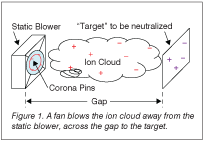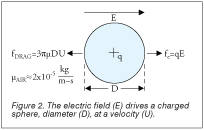Static Beat: When To Use Static Blowers
- Published: February 01, 2010, By By Dr. Kelly Robinson Contributing Editor
Static charge on a film can cause a variety of problems, including attracting dust, generating sparks that can reset machine control logic or ignite flammable vapors, and causing electrostatic sticking of cut sheets. Many good products are available for neutralizing charge on moving films, such as tinsel, ionizing strings, static brushes, and active ionizers (static bars). However, each of these devices must be located properly near the moving film. The gap between the neutralizer and the film surface is a “critical-to-function” dimension. While well-designed brackets and regular maintenance can ensure good neutralizing performance, devices in which the gap is critical simply cannot be used in some applications, such as a winding film roll.

Static blowers are active ionizers that use air flow to carry ions across the gap from the ionizer to the film as illustrated in Figure 1. With the air flow carrying the ions, the gap between the ionizer and film surface is less important. The neutralizing performance of static blowers does not degrade rapidly as the gap grows large, so they can be located several feet away from the film surface or winding roll.
For this reason, static blowers are a great choice for neutralizing winding rolls in which the roll diameter grows. In the electronics industry, ionizing blowers often are used to neutralize assembly work stations.
The air flow is the key to reducing the sensitivity to the gap. Let's take a closer look at the performance of static blowers so that we'll understand that they can be used effectively when the target (object to be neutralized) is stationary. Neutralization by a static blower requires that the target has a long residence time in front of the ion cloud.
Two important performance drivers for static blowers are ion generation rate by the corona pins and ion mobility.
In a static blower, ions are generated by corona pins that are similar to the corona pins in static bars. A typical static blower with one fan has about six corona pins. This static blower has the ion generating capacity roughly equivalent to a 6-in.-long static bar where the pin-to-pin spacing is 1 in. Static blowers generate relatively few neutralizing ions, so a target with a high level of static charge must sit in front of a static blower for a long time to gather enough neutralizing ions.

Ion mobility measures how quickly ions can be driven through the air by an electric field as illustrated in Figure 2. Here an ion is modeled as a small, charged sphere. We can apply Stokes' drag to get a rough estimate of this ion's mobility.
To find the mobility (b), set the drag force equal to the electrostatic force and solve for the velocity (U) resulting in Equation 1. For a 100-nm-dia sphere with one electronic charge, the mobility (b) is 1×10-8 m2/(V-S), which is about the mobility of corona ions in air.

Ion mobility plays two roles in the performance of static blowers. The result is that only a few of the ions formed by the corona pins are transported away from the blower and become available to neutralize the target. For this reason, the target must have a long residence time within the ion cloud to become neutralized. First, focus on neutralizing the target. We want ions with higher mobility so that the electric field of the charged target easily can draw neutralizing ions from the cloud and pull them to the target. $5 deposit casino
Now, think about getting the ions away from the static blower and into the ion cloud. Once the corona pins do their job and create the neutralizing ions, we want the air flow to drag the ions away from the grounded chassis of the static blower and the motor winding of the fan. For good ion transport away from the static blower, we need ions with lower mobility. This trade-off between getting ions into the ion cloud and drawing ions from the ion cloud limits the neutralizing performance of static blowers.
Static blowers are a commercially important technology for neutralizing static charge, and they are effective when the target is stationary. For example, static blowers are an excellent choice for neutralizing a winding stock roll because the stock roll has a long residence time in front of the static blower.
Static control expert Dr. Kelly Robinson, president of Electrostatic Answers, has 27+ years of experience in problem-solving and consulting. Contact him at 585-425-8158; This email address is being protected from spambots. You need JavaScript enabled to view it.; www.electrostaticanswers.com.





